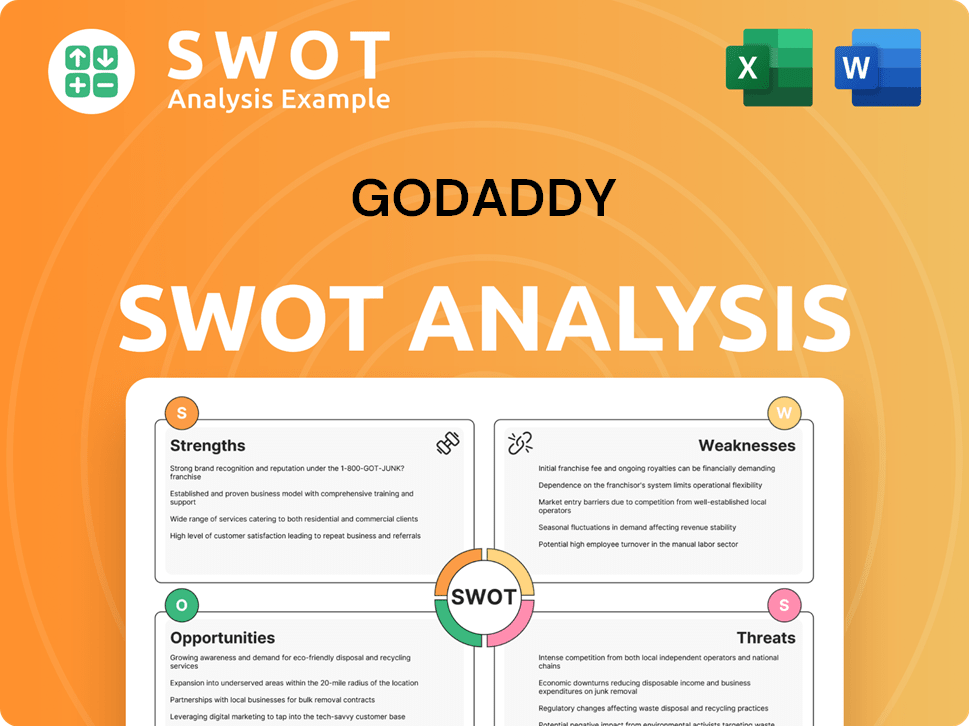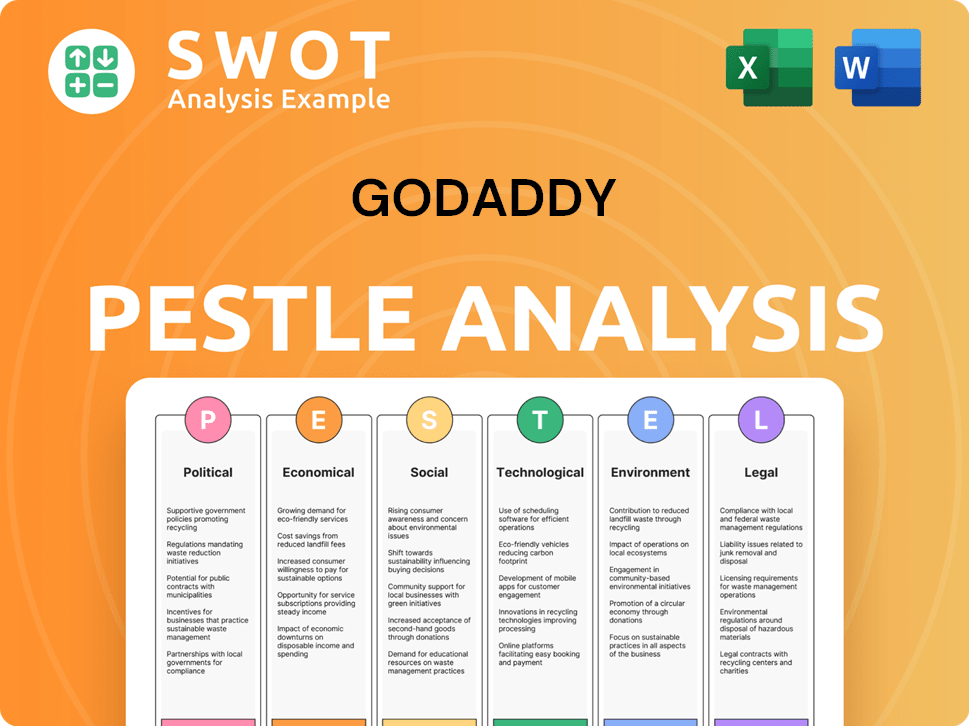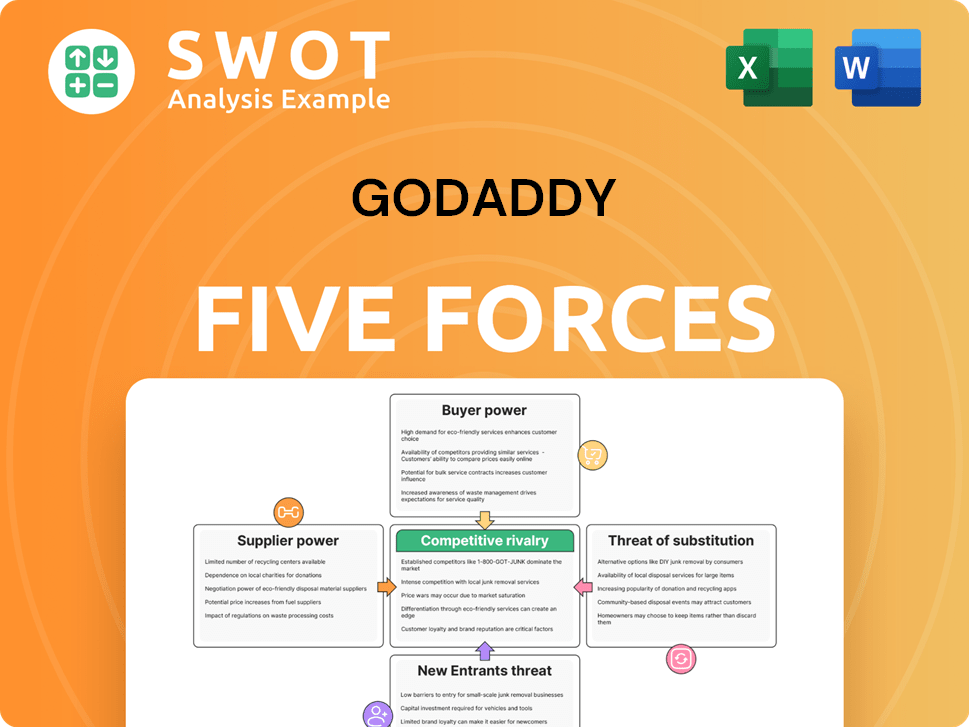GoDaddy Bundle
Who Really Controls GoDaddy?
Ever wondered who pulls the strings at one of the world's largest domain registrars and web hosting providers? Unraveling the GoDaddy SWOT Analysis is key to understanding its market dominance. This deep dive into GoDaddy ownership will reveal the key players shaping its future. Knowing who owns GoDaddy is essential for grasping its strategic direction and potential for growth.

From its humble beginnings to its current status as a publicly traded giant, the GoDaddy history is a fascinating tale of evolution. Understanding the GoDaddy parent company and its ownership structure is crucial for investors and anyone interested in the digital landscape. We'll explore the shifts in power, from the founders to the institutional investors, and examine how GoDaddy stock performance reflects these changes, including the influence of the GoDaddy CEO.
Who Founded GoDaddy?
The company, initially named Jomax Technologies, was founded in 1997 by Bob Parsons. Parsons, a successful entrepreneur, established the company with the goal of simplifying the process of getting online for small businesses and individuals. His background in software development provided a strong foundation for this venture. The early focus was on affordable domain registration and web hosting services.
In the early stages, Parsons was the sole founder and primary owner. Initial funding primarily came from Parsons himself, leveraging capital from his previous ventures. This bootstrapping approach allowed the company to maintain control during its early growth phase. There is no widely publicized information about early ownership disputes or significant buyouts in the company's formative years.
Parsons maintained significant control and decision-making power as the company rapidly grew. This concentrated ownership structure enabled swift action in a rapidly expanding market. The company's operational strategies and product development during this period directly reflected the founding team's vision. This approach helped GoDaddy establish a strong presence in the domain registration and web hosting market.
Bob Parsons founded the company in 1997. Initially, it was named Jomax Technologies.
Early funding came from Parsons himself. He used capital from previous ventures to support the company.
Parsons maintained significant control. He had the power to make decisions as the company grew.
The focus was on affordable domain registration. Also, web hosting services were a key part of the strategy.
The concentrated ownership enabled rapid action. This was crucial in the expanding market.
Operational strategies reflected the founding team's vision. This helped shape the company's direction.
The early years of GoDaddy, under Bob Parsons' leadership, were marked by a clear vision and a focused approach to the market. The company's success in its formative years set the stage for its later growth and expansion. Understanding the Target Market of GoDaddy helps to understand the evolution of the company. As of 2024, GoDaddy continues to be a major player in the domain and hosting industry, serving millions of customers worldwide. GoDaddy's current CEO is Aman Bhutani, who brought his experience from Expedia Group.
GoDaddy SWOT Analysis
- Complete SWOT Breakdown
- Fully Customizable
- Editable in Excel & Word
- Professional Formatting
- Investor-Ready Format

How Has GoDaddy’s Ownership Changed Over Time?
The GoDaddy history reveals a significant transformation in its ownership structure. Before its initial public offering (IPO), the company was primarily under the control of private equity firms. Key players included KKR, Silver Lake Partners, and Technology Crossover Ventures (TCV). These firms acquired a majority stake in 2011 for approximately $2.25 billion, marking a pivotal shift in the company's direction.
The transition to a publicly traded company occurred on April 15, 2015. The IPO, under the ticker symbol 'GDDY' on the New York Stock Exchange, raised about $460 million, with an initial market capitalization of around $4.5 billion. Following the IPO, major shareholders like KKR, Silver Lake, and TCV gradually reduced their stakes through secondary offerings. The current ownership of GoDaddy is largely dispersed among institutional investors.
| Event | Date | Impact on Ownership |
|---|---|---|
| Private Equity Acquisition | 2011 | KKR, Silver Lake, and TCV acquired majority stake |
| Initial Public Offering (IPO) | April 15, 2015 | Transition to public ownership; reduced private equity holdings |
| Shareholder Activity | Late 2024-Early 2025 | Institutional investors become major shareholders; ongoing adjustments |
As of late 2024 and early 2025, the major shareholders of GoDaddy include institutional investors like The Vanguard Group, BlackRock, and Capital Research Global Investors. These firms collectively hold a significant portion of the outstanding shares, influencing company strategy. While Bob Parsons, the founder, stepped down as executive chairman in 2018, he still retains a notable individual stake. This evolution from founder-led to private equity-backed to widely held public ownership has shaped GoDaddy's strategic focus, emphasizing profitability and shareholder returns. The current GoDaddy CEO and their background continue to influence the company's direction.
The ownership of GoDaddy has evolved significantly, from private equity control to a public company with dispersed institutional ownership.
- Private equity firms like KKR, Silver Lake, and TCV initially held a majority stake.
- The IPO in 2015 marked a shift to public ownership, with institutional investors now holding significant shares.
- The current ownership structure influences GoDaddy's strategic direction and focus on shareholder value.
- Understanding the GoDaddy parent company and its major shareholders is crucial for assessing its market position.
GoDaddy PESTLE Analysis
- Covers All 6 PESTLE Categories
- No Research Needed – Save Hours of Work
- Built by Experts, Trusted by Consultants
- Instant Download, Ready to Use
- 100% Editable, Fully Customizable

Who Sits on GoDaddy’s Board?
The current Board of Directors at GoDaddy, as of early 2025, shapes the company's governance, reflecting its ownership structure. The board includes independent directors, representatives from significant institutional investors, and current or former executives. While specific board members representing major shareholders like Vanguard or BlackRock are not explicitly named as direct representatives, their influence is felt through their engagement and voting on proxy matters. This structure ensures a mix of perspectives, balancing internal expertise with external oversight.
The board's composition is crucial for overseeing strategic direction, executive compensation, and risk management. The presence of independent directors ensures a degree of impartiality in decision-making. The influence of major institutional investors is exerted through their voting power and engagement with the company on key issues. These investors often have significant holdings, making their input vital in shaping the company's long-term strategy and financial health. The board's decisions directly impact the value of GoDaddy stock and the overall success of the business.
| Board Member | Title | Affiliation |
|---|---|---|
| Mark S. Vranesh | Lead Independent Director | Independent |
| Aman Bhutani | CEO | GoDaddy |
| Charles J. (Chuck) Robel | Director | Independent |
GoDaddy operates primarily under a one-share-one-vote structure, meaning each common share typically carries one vote. This structure promotes a democratic voting process among shareholders. In recent years, GoDaddy has not been subject to significant public proxy battles or activist investor campaigns that have dramatically reshaped its decision-making. The company's governance appears to be relatively stable, with the board overseeing strategic direction. Understanding the Competitors Landscape of GoDaddy is also essential to assess the company's position in the market.
GoDaddy's voting structure is straightforward, with each share generally carrying one vote. This democratic approach ensures that all shareholders have a proportional say in company decisions.
- One-share-one-vote structure.
- No dual-class shares are known.
- Board oversees strategic direction.
- Governance is relatively stable.
GoDaddy Business Model Canvas
- Complete 9-Block Business Model Canvas
- Effortlessly Communicate Your Business Strategy
- Investor-Ready BMC Format
- 100% Editable and Customizable
- Clear and Structured Layout

What Recent Changes Have Shaped GoDaddy’s Ownership Landscape?
Over the past few years, from roughly 2022 to early 2025, the ownership structure of the company has continued to evolve. The trend includes ongoing divestment by former private equity owners, such as KKR and Silver Lake, who have progressively reduced their holdings. This shift has led to a more distributed ownership among public shareholders. Institutional investors, including major players like Vanguard and BlackRock, have increased their stake, solidifying their influence. As of early 2024, institutional investors collectively held a significant portion of the company's shares.
The company has implemented share buyback programs, which can influence ownership percentages by reducing the number of outstanding shares. There have been no public announcements about a privatization or a new major strategic investor taking a significant stake. Leadership transitions, such as changes in the CEO role, have occurred, but these typically do not fundamentally alter the ownership structure. The company remains focused on its core business, influenced by the substantial presence of its institutional investor base. For more context, you can explore the Brief History of GoDaddy.
| Metric | Details | Data (as of early 2024) |
|---|---|---|
| Institutional Ownership | Percentage of shares held by institutional investors | Approximately 70-75% |
| Share Buybacks | Impact on outstanding shares | Ongoing, reducing the total number of shares |
| Major Shareholders | Key institutional investors | Vanguard, BlackRock, and others |
The company's ownership structure is primarily characterized by a high degree of institutional ownership, with significant influence from large asset managers. Share buyback programs have been a consistent feature, returning value to shareholders and subtly altering ownership percentages. While there have been leadership changes, the core ownership structure remains largely unchanged, reflecting a stable, publicly traded company.
The current ownership of the company is primarily distributed among public shareholders, with a substantial portion held by institutional investors. Key players include large asset managers like Vanguard and BlackRock. The ownership structure has evolved over time, with private equity firms reducing their stakes.
Institutional investors collectively hold a significant majority of the company's shares. Their influence is considerable, shaping the company's strategic direction and financial performance. This ownership structure is typical for large-cap public companies.
The company has engaged in share buyback programs, which reduce the number of outstanding shares. These programs increase the proportional ownership of remaining shareholders. They are often a way to return value to shareholders.
Leadership transitions, such as changes in the CEO role, have occurred, but these typically do not fundamentally alter the ownership structure. The company remains focused on its core business while exploring new avenues for growth.
GoDaddy Porter's Five Forces Analysis
- Covers All 5 Competitive Forces in Detail
- Structured for Consultants, Students, and Founders
- 100% Editable in Microsoft Word & Excel
- Instant Digital Download – Use Immediately
- Compatible with Mac & PC – Fully Unlocked

Related Blogs
- What are Mission Vision & Core Values of GoDaddy Company?
- What is Competitive Landscape of GoDaddy Company?
- What is Growth Strategy and Future Prospects of GoDaddy Company?
- How Does GoDaddy Company Work?
- What is Sales and Marketing Strategy of GoDaddy Company?
- What is Brief History of GoDaddy Company?
- What is Customer Demographics and Target Market of GoDaddy Company?
Disclaimer
All information, articles, and product details provided on this website are for general informational and educational purposes only. We do not claim any ownership over, nor do we intend to infringe upon, any trademarks, copyrights, logos, brand names, or other intellectual property mentioned or depicted on this site. Such intellectual property remains the property of its respective owners, and any references here are made solely for identification or informational purposes, without implying any affiliation, endorsement, or partnership.
We make no representations or warranties, express or implied, regarding the accuracy, completeness, or suitability of any content or products presented. Nothing on this website should be construed as legal, tax, investment, financial, medical, or other professional advice. In addition, no part of this site—including articles or product references—constitutes a solicitation, recommendation, endorsement, advertisement, or offer to buy or sell any securities, franchises, or other financial instruments, particularly in jurisdictions where such activity would be unlawful.
All content is of a general nature and may not address the specific circumstances of any individual or entity. It is not a substitute for professional advice or services. Any actions you take based on the information provided here are strictly at your own risk. You accept full responsibility for any decisions or outcomes arising from your use of this website and agree to release us from any liability in connection with your use of, or reliance upon, the content or products found herein.